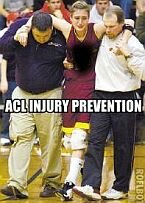ACL Injuries in Female Athletes
ARE YOU A PARENT OF A FEMALE ATHLETE? DON'T LET THIS HAPPEN TO YOUR CHILD!
YOU CAN FIND OUT IN 30 SECONDS IF YOUR CHILD IS AT RISK FOR A DEVASTATING INJURY...
CLICK HERE TO SCHEDULE AN APPOINTMENT
"You can prevent ACL injury. If you have a daughter who is playing basketball, soccer [or other field or court sports], then it is crazy if her team isn't undertaking one of the evidenced based warm-ups targeting lower limb injury prevention."
British Journal of Sports Medicine, October 2008

|
ACL INJURY PREVENTION PROGRAM by Dr. Steve Horwitz I have been teaching athletes, parents, and coaches about preventing ACL injuries for a decade. For some reason, this information is not getting to the people that need it.....YOU and your daughters! In order to solve this problem, I have developed the ACL INJURY PREVENTION PROGRAM! Click here for more information! |
Female Athletes Have Arrived
More women and girls are playing sports than ever before. The spectacular performance of the women in the 1996 and 2000 Olympics and the popularity of women's professional soccer, basketball, golf and tennis have had a profound influence on little girls. Forget about "Be like Mike," instead "Be like Mia!"
The speed, power, and intensity of women's sports have dramatically increased over the past decade. With this style of play has come an increase in musculoskeletal injuries. One of the more common injuries is a sprain or rupture of the ACL (Anterior Cruciate Ligament) of the knee.
Read The The Uneven Playing Field by Michael Sokolove in the NY Times Magazine, May 11, 2008
Anatomy of the Knee

The anterior cruciate ligament (ACL) is one of four main ligaments of the knee. It is located inside the knee and runs from the thigh bone (femur) to the shin bone (tibia).
Its functions are to keep the tibia (shin bone) from sliding forward on the knee and to stabilize the knee when it twists (rotation). So in straight-ahead sports like jogging, swimming, and biking, there is little stress to the ACL. But in the sports that involve cutting, planting and changing direction (football, soccer, basketball, skiing, gymnasics, field hockey, ice hockey, wrestling, lacrosse, rugby, tennis) the ACL plays a vital role.
Injury Statistics

According to 1998 injury statistics from the U.S. Consumer Product Safety Commission, more than 81,600 people injured their knee playing soccer, and 225,800 sustained injuries in basketball. Gymnastics, soccer and basketball are followed by field hockey, volleyball, lacrosse and softball as sports that cause ACL injury in females. (4)
Studies show that women are 2 to 8 times as likely as men to have an ACL injury. (4) In 1995, an article was published in the American Journal of Sports Medicine that found that female basketball players in the NCAA tore their ACLs four times more often than male basketball players. In the same study, women who played NCAA soccer sustained ACL injuries twice as often as male soccer players.
An estimated 200,000 ACL injuries occur annually in the United States. Approximately 60,000-75,000 ACL reconstructions are performed each year.(6)
Causes of Injury
The reasons why this is the case are not easily explained. It is helpful to divide these causes into two groups:
- Mechanisms of Injury
- Anatomical and Hormonal Factors
Mechanisms of Injury

Most ACL injuries are non-contact related: running and cutting sharply in a more erect posture than in men, landing from a jump without bending the knees sufficiently, and playing on surfaces with a high coefficient of friction. The level of skill and experience of the athlete is always of significance. Of course, contact injuries like a direct blow to the knee from the rear or side can cause a tear in the ACL. The tear usually occurs in the mid-portion of the ligament which is the weakest part.
"Commonly, the athlete runs, suddenly stops, and then turns, thereby causing a deceleration of the lower limb, a forced hyperextension of the knee, or a forced tibial rotation...." "Other mechanisms include an internal rotary force applied to a femur on a fixed weight-bearing tibia, an external rotation force with a valgus [outward] force, or a straight anterior force applied to the back of the leg, forcing the tibia forward relative to the femur." (4)
Noncontact injury
An audible pop often accompanies this injury, which often occurs while changing direction, cutting, or landing from a jump (usually a hyperextension/pivot combination). Within a few hours, a large hemarthrosis develops. Patients usually are unable to return to play, secondary to pain, swelling, and instability or giving way of the knee.
Contact and high-energy traumatic injuries
These injuries often are associated with other ligamentous and meniscal injuries. The classic "terrible triad" involves a valgus stress to the knee with resultant injury to the ACL, Medial Collateral Ligament (MCL), and medial meniscus.(6)
Anatomical and Hormonal Factors
1. Intercondylar notch size. This is the groove in the femur through which the ACL travels. The size and shape of the notch tends to be smaller in women. This narrowness may predispose women to higher rates of ACL injury. Not only is this groove smaller in women, but the actual size of the ACL itself (MRI cross section of the ACL in a man averaged almost 14 millimeters larger than in females at the width of the space through which the ACL travels) is smaller in women (1).
2. Pelvis size. Women typically have a wider pelvis, which makes the thigh bones angle downward more sharply than in men. This is called the "Q" angle. The greater the angle, the more pressure put on the inside (medial aspect) of the knee. (3)
3. Ligament laxity. Women's ligaments can be more lax (have more give) than men's ligaments. Also, research has shown that women's muscle tissue is more elastic than male muscle tissue. Therefore, excessive joint motion combined with increased flexibility may be an important cause for women tearing their ACL at a higher rate. (3) As a women approaches the end of knee extension, the femur glides forward more than in men. (4)
4. Reflex time. It has been shown that female muscles stabilizing the knee may take a millisecond longer to respond than their male counterparts. It is suspected that this small difference in the time of contraction to protect the knee could also lead to injury. (3)
5. Quadriceps/Hamstring Strength Ratio. The hamstrings reduce forward motion of the tibia (tibial translation) in synergy with the ACL. "In men, the hamstring is recruited first to stabilize the knee during anterior tibial translation. On the other hand, women rely more on the quadriceps [front thigh muscle] and gastrocnemius [calf] to resist anterior tibial translation." (4)
Poor hamstring strength in both sexes may be a cause for ACL injury. If the hamstring cannot balance the power of the quadriceps, then this imbalance can cause significant stress to the ACL. (3)
6. Hormones. A recent study suggests that changes in estrogen levels during the menstrual cycle may affect the strength of the ACL. This may predispose women to the higher injury rate. (3)
Return To Play (5)
A four phase return to play should be followed to safely return the athlete to the playing field:
- Functional Balance and Core Strength
- Normal walking gait
- Normal running gait with complete range of motion
- Double leg squat
- Functional Strength
- Bilateral symmetry in balance
- b. Single leg squat
- Power
- Double and single leg plyometric exercises
- Sport Specific Symmetry
- Running and jumping training in all planes of motion: forward/backward, side to side, rotation.
Injury Prevention: The Good News
Multiple studies have shown that a proper training program can be very effective at decreasing the rate of ACL injury.
"A training program developed at the University of Vermont Medical School designed to prevent ACL injuries in skiers demonstrated a 69% decrease in injuries among ski patrol personnel and instructors who received the training compared with those who did not. Another prevention program developed in Cincinnati demonstrated that a six week program of training could reduce the risks of knee ligament injuries in female athletes. One of the important aspects of the training program is to train these athletes to rely more on hamstring muscles than quadriceps, thereby protecting the knee ligaments. A controlled study of women athletes who did not participate in the training program compared with those who did indicated a five times higher incidence of knee injury than in male athletes. Females who participated in the training had injury levels equal to or only one or two times higher than males." (2)
How You Can Prevent ACL Injury

- Proper leg muscle strength and flexibility training as well as core training.
- Proper neuromuscular (balance and speed) training. A proper training program would include squats, lunges, stiff-leg deadlifts, hamstring curls, and different types of jumping movements. These jumping movements would progress from:
- slow jumps landing on two legs in one plane of motion
- slow jumps landing on two legs in multiple planes of motion (front to back, side to side, and rotation)
- slow jumps landing on one leg in one plane of motion
- slow jumps landing on one leg in multiple planes of motion
- faster jumps landing on one or two legs in multiple planes of motion
- Proper coaching on jumping and landing and avoiding any straight knee landing.
- Proper footwear and orthotics if necessary.
See our SPORTS PERFORMANCE TRAINING to get one on one instruction!
References
- ACL Injuries in Women
- Pettineo, et. al. Female ACL Injury Prevention With a Functional Integration Exercise Model. Strength and Conditioning Journal. Vol 26 No1, pp.28-33.
- Anterior Cruciate Ligament Injury
|
The Ultimate Nutritional Lie Detector Test LEARN MORE 
|
Kettlebell Rehab

Click Here
To See How Kettlebells will transform your body!
Vortex Rehab

Click Here
To See How This
Revolutionary Machine
Can Help You!
Partner / Support

Loans up to 3 months - fast cash advances for up to 90 days and up to $5,000!


















